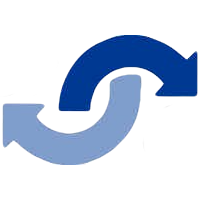In part two of our deep dive into HR burnout, we’re exploring the effects that the pandemic has had on working from home versus working from the office, layoffs, hiring and staffing concerns, and what this all meant for HR departments world-wide.
Transitioning to Remote Working
From the near-beginning of 2020, as workplaces began to close their office doors due to the start of COVID-19, HR departments became tasked with assisting in the transition of employees to work-from-home scenarios. This task has included everything from gathering information from the news about ever-changing pandemic safety protocol, collaborating with CEOs and managers to create work-from-home policies and procedures, to filtering down those messages to the employees and addressing their questions and concerns.
Research | Leadership | Communication
This massive shift in the way that the workplace operates and how work gets done has created obstacles for every member of work teams internationally, with HR departments at the forefront of it all. Many operational HR professionals had an opportunity to really step into strategic roles, where their voices not only mattered, but were critical to business success and continuity.
Although the popular take is that companies should do everything in their power to transition to remote workforces, there are many reasons that working from home can create challenges for some employees.
Factors such as childcare, not having a home office or quiet space, lack of access to reliable wifi, sharing their space with a partner or roommate, and even pets, can all create challenges. This, in combination with numerous other issues that the pandemic has brought on, has led to people having to leave their jobs altogether or being let go by their employers. Handling this back-and-forth between employees and employers, as well as completing the ongoing on- and off-boarding process, are two of the many circumstances that have had HR leaders feeling overwhelmed to say the least.
Even if they are able to conveniently work from home, the shift to working remotely has been a big adjustment for HR leaders as well. When one of your primary duties is to be a voice to the company, doing so without the ability to have face-to-face interactions can often complicate and change these interactions entirely. This has affected not only the HR department but the employees who rely on them for important workplace communication. Responsibilities like relaying sensitive information between employees and employers, checking in on the well-being of the staff, and conducting multiple layoffs especially becomes more difficult when all meetings are virtual.
High EQ HR professionals have recognised that the effort it takes to genuinely connect with team members requires significantly longer and more thoughtful connection, than being able to see physical signs of their employees struggling (or celebrating).

Layoffs, Re-Hiring, and Staffing Concerns
Studies have shown that the constant change and fluctuation within the job market has been immense since the beginning of the pandemic. With over 130,000 COVID-19 layoffs in Canada alone, the past 19 months have unleashed a slew of unprecedented additional work onto HR leaders. Add to this the droves of employees who have left their jobs since 2020 and it paints a clear picture of the stress that HR departments have had to face with off-boarding duties alone. Staffing concerns haven’t only been layoffs, people leaving, and off-boarding procedures. As discussed in part 1 of our HR Burnout blog series, all of these issues combined have ended with, in countless offices, a severely understaffed company, and a very tired and burnout HR department that has been responsible for handling all of the most challenging parts of these processes. The glaring question mark for workplaces and HR professionals has become how to handle the staffing of their company with all of the trepidations of a world-wide pandemic in the way.
Navigating the Unknown
Leading into the Summer of 2021, as COVID-19 vaccinations became more widely available, workplaces have begun the undertaking of re-opening their office doors, re-hiring and re-building their teams. While on the surface this has helped to aid the understaffing issues, the behind-the-scenes workload has had HR leaders scrambling to entirely change their directions once again. Filling new openings throughout an organization’s various departments has now become one of the most challenging aspects of the world’s new work climate, and therefore one of the most difficult elements of an HR leader’s day-to-day workload. The competitive nature of employers attracting the best candidates in an environment where job-seekers could be presented with numerous potential offers, has continued to add to the pressure onto the HR department.
At Career Contacts, we are seeing our candidates fielding multiple offers every day, and supporting our clients with ensuring they have the most streamlined, candidate centric, and competitive process in place to increase their chances of their offers being accepted.
Our recruitment and HR team have provided support by enhancing compensation plans, providing leadership with training and development to source and screen candidates, continued to improve candidate and employee experiences, and so much more. Living and breathing Kaizan (continuous improvement) has created such an incredible opportunity for tangible growth and success for our clients.
HR professionals continue to ensure that their company is offering all of the best and most appealing attributes for job-seekers. This includes staying up to date on competitive salaries for each position, designing an attractive benefits package, and coming up with flexible work arrangements such as work-from-home versus work-from-office hybrid capabilities.
Additionally, more employers have now asked their HR teams to determine how to offer the most comprehensive pandemic and post-pandemic-related health and wellness resources to potential candidates. While we whole heartedly believe that health and wellness plans are critical to retaining employees in any workplace environment, it is yet again, another item on the agenda of the HR team that now needs to be updated and checked off frequently.
Increased Workloads | Health and Wellness

Transitioning Back to Working from the Office and New Health Protocol
While it might seem that transitioning back to working from the office is a return to some form of “normal”, the pandemic is continuing to shape and mould the workplace into a completely new environment.
With COVID cases continuing to arise and the addition of the Delta Variant introduced, health and safety protocols are required to be updated regularly, leaving HR departments with a laundry list of procedures, requirements, and concerns to relay back and forth between employees and employers. Without precedents to rely on, HR is having to lean on their legal partners for increased support.
Having employees back in the office means engaging in conversations around masks, vaccinations, and social distancing; all of which have been surrounded by tension, debate and like it or not, politics. This also means discussing which departments and employees will be required to return to the office, if any, and if there will be a potential for certain roles to become fully remote or hybrid positions, which is another conversation that also has the possibility to become contentious. Equity should always be top of mind whenever new policies and practices are created, and balancing equity with being mindful of individual circumstances, takes a certain skillset that not everyone within HR has experience or training in.
HR is now responsible for shepherding employers through these conversations on the back end as well as guiding employees through them, all while bearing the potential and often very real criticism from either end. Addressing the safety and emotional concerns of the team is also at the forefront of the HR department as the transition to working from the office begins. Some team members may have faced the loss of a family member in the past 19 months. Some may have pre-existing health issues or live with someone who is immunocompromised and therefore have an aversion to working from the office while COVID continues. Every employee deserves to be heard and supported when possible, and this determination and decision making will often fall to, you guessed it, HR.
Important to note that through all of this, HR has been critical to organizations being able to be candidate and employee centric, heart lead leaders and seeing continued success. We are grateful to have our voices heard and our opinions form meaningful discussion and change.
All of the elements mentioned in part one and part two of this series would be a lot for HR professionals to handle in general, but add to all of this the weight of working through a world-wide pandemic and it becomes even more evident why HR burnout has become an increasingly common topic of discussion. In part 3 of our HR burnout series we will be delving into how the pandemic has effected mental health as a whole, mental health policies, and where to go from here in terms of HR departments being able to best support their employees, and how employers can best support their HR teams as well.
To continue with us in our break-down of HR burnout, be sure to stay tuned to our Blog and follow us on LinkedIn for more HR tips and resources!


